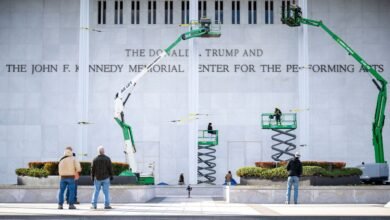
It is surely a reflection of our scattered and distracted era that the country sailed, this year, into a widely anticipated storm in Washington without a plan for navigation or a clear idea of what to keep safe. Since January, when Donald Trump reëntered the White House, basic practices of freedom, order, justice, and democracy have been upended. The President has sought to use the powers of his office to impede his legal adversaries. Last month, the government flew unidentified Venezuelan men whom it described as gang members to a Salvadoran prison without due process or dates for release. The shock is not simply the catalogue of constitutional infractions, which goes on queasily, or the course of change, which has been costly and swift. It’s the scarce challenge that these upheavals have received, and the alacrity with which institutions have indulged the White House’s whim. The Washington Post, apparently on the decision of its owner, Jeff Bezos, is now constrained to editorials of market-friendly positions. The law firms Paul, Weiss and Skadden, Arps answered criticism with pro-bono service to an Administration that has little regard for the law. Our proud civil institutions of democracy, the ones we thought would shield us from bad autocratic weather, are inverting like drugstore umbrellas in a gust of morning rain.
For many people, the most disturbing responses are from the universities. Higher education is a realm in which the United States still sets the global standard. The habits of democracy—free individual inquiry, clear evidence-based thinking, an aversion to bunk—are academic habits, and university research in everything from nanoelectronics to cancer is the foundation of industry and medicine. To many Trumpists, though, the diversity and the authority of the academy stands as a threat. “I actually think that we have to destroy the universities in this country. They get too much money. They have too much power. I don’t think they do anything good,” J. D. Vance, a graduate of Ohio State University and Yale Law School who went on to become the Vice-President of the United States, said, in 2021.
In this magazine last month, I reported on how the Administration is exploiting sources of campus tension—debates about the best path to diversity, disputes about protest for Israel and Gaza—in order to threaten federal funding. Through Title VI of the Civil Rights Act of 1964, an anti-discrimination law, universities’ failure to discipline antisemitism on campus can be grounds for funding cuts. My story centered on Harvard, a bellwether campus where strong forces crossed, but I could have focussed almost anywhere. The piece appeared on a Monday. By Friday, Trump had announced plans to sanction schools that allowed “illegal protests,” while cancelling four hundred million dollars in federal funds to Columbia. (Johns Hopkins, one of the country’s leading medical-research centers, was targeted for greater losses, of eight hundred million dollars in grants.) Antisemitism ran wild at Columbia, as it ran wild elsewhere, the Administration alleged, yet its list of demands to the university—such as changing Columbia’s disciplinary structures and placing the Middle Eastern, South Asian, and African Studies department under receivership, or special oversight—seemed committed to undermining not bigotry but academic autonomy. When, three weeks ago, Columbia made accommodations widely regarded as concessions to the requests, commentators erupted. “Columbia’s capitulation last week to the Trump administration, in which it agreed to a number of demands in order to restore federal funding, obliterates its leadership in defending free inquiry,” a former provost at the school wrote, in the Times. Columbia’s interim president, Katrina Armstrong, announced her resignation late last month.
Yet Columbia was not alone in its acquiescence. Other schools have bowed before being pressed. In February, Ohio State University shuttered two inclusion offices and eliminated sixteen staff positions. Last month, the New College of Florida fired a Chinese-language professor who sought asylum, out of what appeared to be a preëmptive worry that his nation of origin—from which he had arrived legally, but which state law identified as a “country of concern”—might bring federal scrutiny to the campus. N.Y.U. cancelled a presentation by a former president of Doctors Without Borders, because, by her account, she had included one slide on casualties in Gaza and another on cuts to U.S.A.I.D. Late last month, in the name of controlling institutional speech, the University of Minnesota, one of the country’s leading public universities, removed six collectively written faculty statements about Israel and Palestine from its website.
“I know of no precedent where a university is cherry-picking topics and saying, ‘These are too hot for public conversation,’ ” Michael Gallope, the chair of the department of cultural studies and comparative literature at Minnesota, told me. The university had begun removing statements that were in support of Ukraine; he worried that writing on other subjects at odds with Trump’s views, such as climate change, could also be stripped from memory and record. “I take J. D. Vance seriously when he says that he’s trying to destroy universities,” Gallope said. “I don’t think concessions are going to win us funding, and we’re trading away the tools we’ll need to defend universities in the future.”
To have one ear tuned to higher education and the other to broader events in the country right now is to hear in stereo. The calculus by which universities seem to be making concessions—give a little to hold onto a lot; survival is the principle that makes all other principles possible—appears also to guide institutions such as the legislature and Big Law. Trump tries to elicit deference and other rewards by imposing targeted punishments in an environment where those who earn his favor are allowed to thrive. Call it the favoritism grift: the more you give to some people while excoriating others, the more you can manage to take.
Consider the President’s odd messaging in advance of announcing new tariffs last week, describing them as “substantial” even as he promised to consider giving “a lot of countries breaks”—an ideal that he reiterated at the National Republican Congressional Committee dinner on Tuesday, proudly claiming that he’d received pleas (“Please, please, sir, make a deal. I’ll do anything!”) before issuing a ninety-day single lowered rate on most tariffs, in anticipation of “bespoke” negotiations. Consider the flamboyant force with which he suddenly went after the Ukrainian President, and the even more erratic logic by which he endorsed his Cabinet selections, many of whom would never make the very long list for a nomination under anybody else. After his national-security adviser, Michael Waltz, included the editor-in-chief of The Atlantic in a Signal chat with top military personnel (to many seasoned eyes, a fireable offense), the President defended him as “a very good man”—a stay in what was surely the most gilded doghouse ever built. As Trump’s favorites receive preferential exemption, his enemies get tailored punishments: no other school seemed to receive exactly the same list of demands that Columbia did, and, as the Times noted, the amount of funding held at bay, four hundred million dollars, was the potential amount that Trump lost out on when, in 2000, Columbia declined to purchase one of his properties. Elephants, at least the ones who golf at Mar-a-Lago, really do remember. For Trump, all policy is personal.
This style of corrupt rule is old. The field of political economics is rich in studies of the ways that autocrats use in-group favoritism to maintain influence, even over those they harm, when institutions are weak. Trump’s favoritism grift breaks from tradition only because he operates in a wealthy, still notionally functioning democracy, where the alternative to supplication isn’t oppression but freedom—albeit under the cloud of the President’s wrath. And, for the loyal, Trump offers something more than mere protection: an apparent path to power itself.
“Élitist” is a word that frequently comes up when people speak of universities, not just because a very small proportion of them have highly selective admissions. Resentment of élite advantage, the dance of special treatment that some institutions receive, is said to help Trump win elections, and that dance tends to be something in which many schools—like politicians, C.E.O.s, fancy lawyers, and the super-rich—are practiced. It is the way these universities distinguish themselves in competing for students, private donations, U.S. News & World Report rankings, and federal funds. (When, in February, the National Institutes of Health capped so-called indirect funding, which covers expenses shared among many labs, it became widely known that many of the most prestigious schools had controversially been receiving special, higher rates.) If the messy balance of scholarship and marketplace which defines American universities is increasingly tipping to the market side, the President’s scheme of gaining power plays into that shift. Trump ran as a populist, but his actions in office have built a new élite shaped by his personal preference and caprice. He has replaced one system of unequal advantage with another, and institutions used to positioning themselves for special favor have been unable to break the habit enough to break away.
Last week, the Trump Administration made clear that it was going after Harvard, reviewing more than two hundred million dollars in federal funds, in addition to what it claims are nearly nine billion dollars in multiyear grants, on the ground that antisemitism had been allowed to flourish there. The move was notable, in part, because Harvard had spent the past year in a cautious, conciliatory crouch to try to ward off just that kind of scrutiny. It cracked down on campus protests, and adopted the International Holocaust Remembrance Alliance’s broad definition of antisemitism. Several days ago, it announced that it was firing the faculty heads of its Center for Middle Eastern Studies, allegedly as a response to complaints that the center’s events programming was insufficiently balanced on the subject of the Israel-Hamas war. None of those efforts appeased the Administration.
Harvard is America’s oldest and wealthiest university, and, like Columbia—or Cornell and Northwestern, both targeted this week—one of the most élite. It is also among the nation’s leading research centers, a beacon for talented young people and scholars across the world, and a campus that is just thirty-three per cent white, and where eighty-five per cent of undergraduates are due to receive some form of financial aid. In pushing universities toward supplication and favor-seeking, Trump calls forth a competitive élite impulse at the cost of a democratic, egalitarian one. Powerful institutions have been inveigled into bartering their strength away by playing for Trump’s favoritism, in part because it is a game they recognize too well.
Yet this is not the time to make sacrifices to get ahead. One wouldn’t necessarily know it right now, but great American universities—like law firms, news outlets, the congressional majority, and other bodies of accountability—hold power in our society, and it’s the power of coördinated work. Their alumni include Americans of influence and of wealth. Their faculties comprise some of the cleverest lawyers in the land. They have long-cultivated relationships in Washington, and their basic scientific research, for better or worse, is the foundation of new products in major industries. To summon all these ranks to action would be to amass a strength against which even a grifting autocrat could barely stand. That summoning is overdue, as is bravery from people with power. For the past months, institutions have let themselves be stalked by the Trump Administration. Now might be the time to turn and begin giving chase. ♦
Source link






